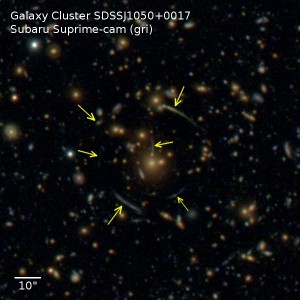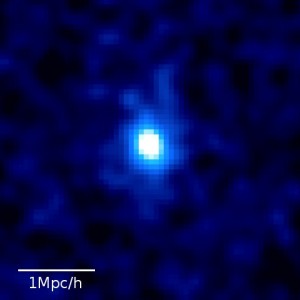Gravitational lensing provides an important means of studying the spatial distribution of dark matter, which cannot be directly seen by usual observations. An international research group led by Masamune Oguri, an assistant professor at IPMU, has made a precise measurement of dark matter distribution in galaxy clusters by analyzing both ‘strong’ and ‘weak’ gravitational lensing phenomena observed in images of 28 galaxy clusters taken at the Subaru 8.2-meter telescope. The result settles a long-standing controversy about the central concentration of dark matter distribution.
Gravitational lensing is the bending of light by gravity. Depending on the strength of the bending it is categorized into two types. One is ‘strong’ gravitational lensing, which causes multiple images or highly distorted images of the distant object to be visible (Figure 1). The other is `weak’ gravitational lensing, which extracts tiny distortion patterns due to gravitational lensing by observing shapes of many distant background galaxies. By combining strong and weak gravitational lensing, we can measure dark matter distribution in galaxy clusters for a wide range from the cores out to the outskirts.
Masamune Oguri and collaborators discovered a large sample of galaxy clusters exhibiting prominent strong gravitational lensing features from the Sloan Digital Sky Survey data, and observed these galaxy clusters with the Subaru Telescope’s Prime Focus Camera (Suprime-Cam) for detailed analysis of gravitational lensing. The team has found that the degree of the central concentration of dark matter distribution is in good agreement with the prediction of the standard model in which dark matter is assumed to be ‘cold’, unlike previous claims that dark matter distribution may be too centrally concentrated. Furthermore, the team has made an unprecedented measurement of the average dark matter distribution in these galaxy clusters, revealing a highly flattened dark matter distribution (Figure2). Such flattened shape has previously been measured by the same researcher (ref. press release on April 26, 2010), and the current result provides independent strong evidence using different sample and analysis method.
One of the goals of the SuMIRe project, which is a survey led by IPMU for uncovering the origin and future of the Universe with the Subaru telescope, is to explore the nature of dark energy via detailed observations of the cosmic evolution of galaxy clusters. This research result marks an important step toward the goal. The result will be published in Monthly Notices of the Royal Astronomical Society, and is also available at the preprint server [here ].
Publication: Monthly Notices of the Royal Astronomical Society
Title: Combined strong and weak lensing analysis of 28 clusters from the Sloan Giant Arcs Survey
Authors: Masamune Oguri (IPMU) and 7 additional coauthors.

Figure 1: Subaru image of SDSSJ1050+0017, one of the galaxy clusters used for the analysis of gravitational lensing. Arrows show background galaxies whose appearance has been distorted by strong gravitational lensing.






